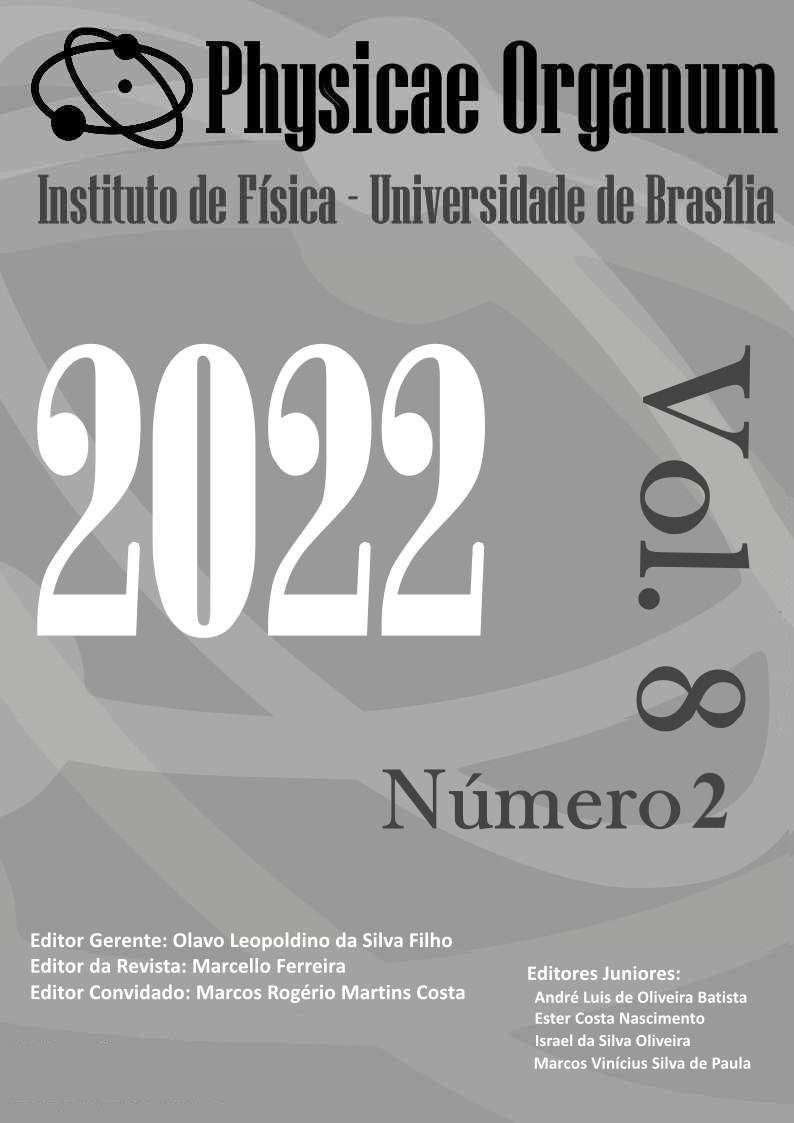O uso do arduino em uma abordagem significativa envolvendo o comportamento dual da luz em experimentos para o ensino médio.
DOI:
https://doi.org/10.26512/2446-564X2022e43414Palavras-chave:
Aprendizagem significativa, Física moderna e contemporânea, TDICs, Experimentação, ArduinoResumo
Neste trabalho empregamos um experimento controlado pelo arduino na abordagem de tópicos de Física Moderna e Comtemporânea, como o comportamento ondulatório e corpuscular da luz, por meio de práticas experimentais envolvendo os fenômenos de polarização da luz e efeito fotoelétrico. Tomando como base conceitos de Aprendizagem Significativa, introduzimos o assunto através de mapas conceituais que auxiliaram na identificação dos subsunçores, empregamos atividades baseadas em Tecnologias Digitais de Informação e Comunicação (TDIC) com o simulador PhET - Simulações Interativas e o Physics at School Lite para discutir os tópicos, montamos sistemas experimentais com circuitos e, por fim, controlamos os experimentos pelo smartfone com o intuito de enriquecer o trabalho através da aquisição de dados quantitativos. Os resultados superaram os objetivos iniciais como ilustrado através das análises dos questionários, concluindo que os estudantes apresentaram uma excelente receptividade aos experimentos realizados, bem como indicaram as ocorrências de diferenciação progressiva e reconciliação integrativa, conceitos inerentes à Teoria da Aprendizagem Significativa.
Downloads
Referências
ANTÔNIO, M.; CALEFI, P. S. Concepções de professores de biologia , física e química sobre a aprendizagem baseada em problemas ( ABP ). p. 1–8, 2013. 58
AUSUBEL, D. Teoria da aprendizagem significativa. PELIZZARI, A. et al, 1993. 50, 66, 71
AUSUBEL, D. P. Aquisição e Retenção de Conhecimentos : Uma. 1ª. ed. Lisboa: PARALELO EDITORA-PORTUGAL, 2003. 243 p. ISBN 972-707-364-6. 55
BAIRRAL, M. A. As Manipulações em Tela Compondo a Dimensão Corporificada da Cognição Matemática. Jornal Internacional de Estudos em Educação Matemática, v. 10, n. 2, p. 99, 2017. ISSN 2176-5634. 56
BARTHEM, R. A Luz. São Paulo-SP: Livraria da Física Editora, 2005. ISBN 9788588325302.52
CARVALHO, A. B. G.; BLEY, D. P. Cultura Maker e o uso das tecnologias digitais na educação: construindo pontes entre as teorias e práticas no Brasil e na Alemanha. v. 26, n. 10, p. 21–40, 2018. 57
CAVALCANTE, M. A.; BENEDETTO, A. D. Instrumentação em Física Moderna para o Ensino Médio : uma Nova Técnica para a Análise Quantitativa de Espectros. Revista Brasileira de Ensino de Fisica, v. 21, n. 3, p. 437–446, 1999. 57
CAVALCANTE, M. A.; TAVOLARO, C. R.; GUIMARÃES, D. Construção de equipamentos didáticos para o estudo da polarização intrínseca do LASER. In: XVI Simpósio Nacional de ensino de Física. [S.l.: s.n.], 2005. p. 7–10. 58
CAVALCANTE M. A.; TAVOLARO, C. R. C.; MOLISANI, E. Física com Arduino para iniciantes. Revista Brasileira de Ensino de Fisica, v. 33, n. 4, 2011. ISSN 01024744. 57
GASPAR, A. Experimentos de Ciências. 1ª. ed. São Paulo-SP: Ática, 2003. ISBN 8508089171. 57,58
HALLIDAY, D.; RESNICK, R. Fundamentos de Física 3: Eletromagnetismo. 3ª. ed. Rio de Janeiro-RJ: LTC, 1993. ISBN 8521607059. 53
HALLIDAY, D.; RESNICK, R. Fundamentos de Física 4: Ótica e Física Moderna. 3ª. ed. Rio de Janeiro-RJ: LTC, 1993. ISBN 8521607083. 53
HEWITT, P. G. Física Conceitual. 11ª. ed. Porto alegre-RS: Bookman Editora, 2011. ISBN 9788577808908. 61
JORENTE, M. J. V. Impacto das tecnologias de informação e comunicaç ão: Cultura digital e mudanças sócio-culturais. Informacao e Sociedade, v. 22, n. 1, p. 13–25, 2012. ISSN 01040146. 56
LIMA, J. F. d. O laser e os conceitos de polarização e efeito fotoelétrico em uma abordagem significativa no ensino médio. Dissertação (Mestrado) — MNPEF-IF/UFF, 2020. 50, 61
MONK, S. Projetos com Arduino e Android. 1ª. ed. Porto alegre-RS: Bookman Editora, 2014. ISBN 9788582601211. 60
MOREIRA, M. A. Aprendizagem significativa, Organizadores prévios, Mapas conceituais, Diagramas V e Unidades de ensino potencialmente significativas. Revista Qurriculum, La Laguna, v. 25, p. 29–56, 2012. ISSN 2175-8042. 56
MOREIRA, M. A.; MASINI, E. F. Aprendizagem Significativa- A Teoria de David Ausubel. 2ª. ed. São Paulo-SP: Centauro, 2006. 114 p. ISBN 9788588208766. 50, 55, 56, 66, 71
NUSSENZVEIG, H. M. Curso de Física Básica: Volume 3 - Eletromagnetismo. 1ª. ed. São Paulo-SP: Editora Edgard Blücher, 2002. ISBN 85-212-0298-9. 51, 53
RAMOS, D. Uma proposta para demonstrações experimentais no ensino de Física: roteiro de experimentos de baixo custo. Uberlândia-MG: [s.n.], 2018. 40 p. 49
RODITI, I. Dicionário Houaiss Física. [S.l.]: Objetiva, 2005. 264 p. ISBN 9788573026948. 51, 53
SEEDUC. Currículo mínimo 2012. 2012. 49
SILVA, M. F. d. Esclarecendo osignificado da "cor"em física. A Física na Escola, v. 8, n. 1, p. 25–26, maio 2007. 68
Instituto de Física 73Physicae Organum, v. 8, n. 2, p. 48-74, Brasília, 2022.
TIPLER, P. A.; LLEWELLYN, R. A. FÍSICA MODERNA. 6ª. ed. Rio de Janeiro-RJ: GEN LTC, 2014. ISBN 9788521626077. 54
Downloads
Publicado
Como Citar
Edição
Seção
Licença
Copyright (c) 2022 Physicae Organum

Este trabalho está licenciado sob uma licença Creative Commons Attribution-NonCommercial-ShareAlike 4.0 International License.
Autores que publicam nesta revista concordam com os seguintes termos:
- Autores mantém os direitos autorais e concedem à revista o direito de primeira publicação, sendo o trabalho simultaneamente licenciado sob a Creative Commons Attribution License o que permite o compartilhamento do trabalho com reconhecimento da autoria do trabalho e publicação inicial nesta revista.
- Autores têm autorização para assumir contratos adicionais separadamente, para distribuição não-exclusiva da versão do trabalho publicada nesta revista (ex.: publicar em repositório institucional ou como capítulo de livro), com reconhecimento de autoria e publicação inicial nesta revista.
- Autores têm permissão e são estimulados a publicar e distribuir seu trabalho online (ex.: em repositórios institucionais ou na sua página pessoal) a qualquer ponto antes ou durante o processo editorial, já que isso pode gerar alterações produtivas, bem como aumentar o impacto e a citação do trabalho publicado (Veja O Efeito do Acesso Livre).




